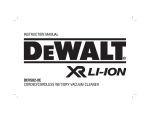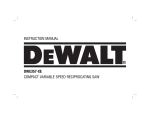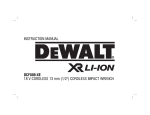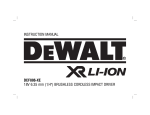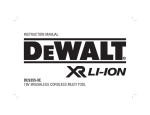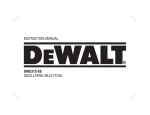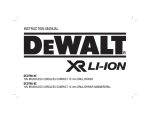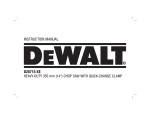Download DeWalt DW341M Instruction manual
Transcript
INSTRUCTION MANUAL DW341-XE HEAVY-DUTY JIG SAW LPA (sound pressure) KPA (sound pressure uncertainty) LWA (sound power) KWA (sound power uncertainty) Definitions: Safety Guidelines The definitions below describe the level of severity for each signal word. Please read the manual and pay attention to these symbols. DANGER: Indicates an imminently hazardous situation which, if not avoided, will result in death or serious injury. WARNING: Indicates a potentially hazardous situation which, if not avoided, could result in death or serious injury. CAUTION: Indicates a potentially hazardous situation which, if not avoided, may result in minor or moderate injury. NOTICE: indicates a practice not related to personal injury which, if not avoided, may result in property damage. mm mm mm mm kg Vibration emission value ah ah,CW = Uncertainty K = m/s² m/s² 5.5 1.6 Vibration emission value ah ah,CM = Uncertainty K = m/s² m/s² 5.3 1.5 The vibration emission level given in this information sheet has been measured in accordance with a standardised test given in EN 60745 and may be used to compare one tool with another. It may be used for a preliminary assessment of exposure. WARNING: The declared vibration emission level represents the main applications of the tool. However if the tool is used for different applications, with different accessories or poorly maintained, the vibration emission may differ. This may significantly increase the exposure level over the total working period. Technical Data V W W min-1 mm 89 3 98 6.6 Vibration total values (triax vector sum) determined according to EN 60745: IF YOU HAVE ANY QUESTIONS OR COMMENTS ABOUT THIS OR ANY DEWALT TOOL, CALL US AT: 1800 654 155 (Aust) or 0800 339258 (NZ). Voltage Power input Power output No-load speed Stroke length Cutting depth in: wood aluminium steel stainless steel alloy Bevel angle adjustment (l/r) Weight dB(A) dB(A) dB(A) dB(A) DW341-XE 230 550 290 0–3100 20 An estimation of the level of exposure to vibration should also take into account the times when the tool is switched off or when it is running but not actually doing the job. This may significantly reduce the exposure level over the total working period. 85 20 10 3 0–45° 2.0 Identify additional safety measures to protect the operator from the effects of vibration such as: maintain the tool and the accessories, keep the hands warm, organisation of work patterns. 1 SAFETY INSTRUCTIONS FOR POWER TOOLS c) Do not expose power tools to rain or wet conditions. Water entering a power tool will increase the risk of electric shock. d) Do not abuse the cord. Never use the cord for carrying, pulling or unplugging the power tool. Keep cord away from heat, oil, sharp edges or moving parts. Damaged or entangled cords increase the risk of electric shock. e) When operating a power tool outdoors, use an extension cord suitable for outdoor use. Use of a cord suitable for outdoor use reduces the risk of electric shock. f) If operating a power tool in a damp location is unavoidable, use a residual current device (RCD) protected supply. Use of an RCD reduces the risk of electric shock. 3) PERSONAL SAFETY a) Stay alert, watch what you are doing and use common sense when operating a power tool. Do not use a power tool while you are tired or under the influence of drugs, alcohol or medication. A moment of inattention while operating power tools may result in serious personal injury. b) Use personal protective equipment. Always wear eye protection. Protective equipment such as dust mask, non-skid safety shoes, hard hat, or hearing protection used for appropriate conditions will reduce personal injuries. c) Prevent unintentional starting. Ensure the switch is in the off position before connecting to power source and/or battery pack, picking up or carrying the tool. Carrying power tools with your finger on the switch or energising power tools that have the switch on invites accidents. d) Remove any adjusting key or wrench before turning the power tool on. A wrench or a key left attached to a rotating part of the power tool may result in personal injury. e) Do not overreach. Keep proper footing and balance at all times. This enables better control of the power tool in unexpected situations. f) Dress properly. Do not wear loose clothing or jewellery. Keep your hair, clothing and gloves away from moving parts. Loose clothes, jewellery or long hair can be caught in moving parts. g) If devices are provided for the connection of dust extraction and collection facilities, ensure these are connected and properly used. Use of dust collection can reduce dust-related hazards. When using power tools, always observe the safety regulations applicable in your country to reduce the risk of fire, electric shock and personal injury. Read the following safety instructions before attempting to operate this product. Keep these instructions in a safe place. WARNING: To reduce the risk of injury, user must read the instruction manual. GENERAL POWER TOOL SAFETY WARNINGS WARNING! Read all safety warnings and all instructions Failure to follow the warnings and instructions may result in electric shock, fire and/or serious injury. SAVE ALL WARNINGS AND INSTRUCTIONS FOR FUTURE REFERENCE The term “power tool” in the warnings refers to your mains-operated (corded) power tool or battery-operated (cordless) power tool. 1) WORK AREA SAFETY a) Keep work area clean and well lit. Cluttered or dark areas invite accidents. b) Do not operate power tools in explosive atmospheres, such as in the presence of flammable liquids, gases or dust. Power tools create sparks which may ignite the dust or fumes. c) Keep children and bystanders away while operating a power tool. Distractions can cause you to lose control. 2) ELECTRICAL SAFETY a) Power tool plugs must match the outlet. Never modify the plug in any way. Do not use any adapter plugs with earthed (grounded) power tools. Unmodified plugs and matching outlets will reduce risk of electric shock. b) Avoid body contact with earthed or grounded surfaces such as pipes, radiators, ranges and refrigerators. There is an increased risk of electric shock if your body is earthed or grounded. 2 • Young children and the infirm. This appliance is not intended for use by young children or infirm persons without supervision. – This appliance is not intended for use by persons (including children) with reduced physical, sensory or mental capabilities, or lack of experience and knowledge, unless they have been given supervision or instruction concerning use of the appliance by a person responsible for their safety. – Children should be supervised to ensure that they do not play with the appliance. • Replacement of the supply cord. If the supply cord or plug is damaged, it must be replaced by the manufacturer or an authorised DEWALT Service Centre in order to avoid a hazard. 4) POWER TOOL USE AND CARE a) Do not force the power tool. Use the correct power tool for your application. The correct power tool will do the job better and safer at the rate for which it was designed. b) Do not use the power tool if the switch does not turn it on and off. Any power tool that cannot be controlled with the switch is dangerous and must be repaired. c) Disconnect the plug from the power source and/or the battery pack from the power tool before making any adjustments, changing accessories, or storing power tools. Such preventive safety measures reduce the risk of starting the power tool accidentally. d) Store idle power tools out of the reach of children and do not allow persons unfamiliar with the power tool or these instructions to operate the power tool. Power tools are dangerous in the hands of untrained users. e) Maintain power tools. Check for misalignment or binding of moving parts, breakage of parts and any other condition that may affect the power tool’s operation. If damaged, have the power tool repaired before use. Many accidents are caused by poorly maintained power tools. f) Keep cutting tools sharp and clean. Properly maintained cutting tools with sharp cutting edges are less likely to bind and are easier to control. g) Use the power tool, accessories and tool bits, etc. in accordance with these instructions, taking into account the working conditions and the work to be performed. Use of the power tool for operations different from those intended could result in a hazardous situation. 5) SERVICE a) Have your power tool serviced by a qualified repair person using only identical replacement parts. This will ensure that the safety of the power tool is maintained. Extension Cords CAUTION: Use only extension cords that are approved by the country’s Electrical Authority. Before using extension cords, inspect them for loose or exposed wires, damaged insulation and defective fittings. Replace the cord if necessary. Additional Specific Safety Rules for Jig Saws • Hold power tools by insulated gripping surfaces when performing an operation where the cutting tool may contact hidden wiring or its own cord. Contact with a “live” wire will make exposed metal parts of the tool “live” and shock the operator. • Use clamps or another practical way to secure and support the workpiece to a stable platform. Holding the work by hand or against your body leaves it unstable and may lead to loss of control. • Allow the motor to come to a complete stop before withdrawing the blade from the kerf (the slot created by cutting). A moving blade may impact the workpiece causing a broken blade, workpiece damage or loss of control and possible personal injury. • Keep handles dry, clean, free from oil and grease. This will enable better control of the tool. • Keep blades sharp. Dull blades may cause the saw to swerve or stall under pressure. • Clean out your tool often, especially after heavy use. Dust and grit containing metal particles often accumulate on interior surfaces and could create an electric shock hazard. Electrical Safety The electric motor has been designed for one voltage range only. Always check that the power supply corresponds to the voltage on the rating plate. 220–240 V AC means your tool will operate on alternating current. Operation at a voltage outside this range can cause loss of power and can result in overheating. All DEWALT tools are factory tested; if this tool does not operate, check the power supply. Your DEWALT tool is double insulated, therefore no earth wire is required. 3 • Do not operate this tool for long periods of time. Vibration caused by the operating action of this tool may cause permanent injury to fingers, hands, and arms. Use gloves to provide extra cushion, take frequent rest periods, and limit daily time of use. WARNING: ALWAYS wear approved protective safety equipment complying with the following standards: • Eye protection: AS/NZS1337 Eye Protectors for Industrial Applications; • Hearing protection: AS/NZS1270 Acoustics – Hearing Protection; • Respiratory protection: AS/NZS1716 Respiratory Protective Devices. WARNING: Some dust created by power sanding, sawing, grinding, drilling, and other construction activities contains chemicals known to cause cancer, birth defects or other reproductive harm. Some examples of these chemicals are: • lead from lead-based paints, • crystalline silica from bricks and cement and other masonry products, and • arsenic and chromium from chemically-treated lumber (CCA). Your risk from these exposures varies, depending on how often you do this type of work. To reduce your exposure to these chemicals: work in a well ventilated area, and work with approved safety equipment, such as those dust masks that are specially designed to filter out microscopic particles. • Avoid prolonged contact with dust from power sanding, sawing, grinding, drilling, and other construction activities. Wear protective clothing and wash exposed areas with soap and water. Allowing dust to get into your mouth, eyes, or lay on the skin may promote absorption of harmful chemicals. WARNING: Use of this tool can generate and/or disburse dust, which may cause serious and permanent respiratory or other injury. Always use AS/NZS1716 approved respiratory protection appropriate for the dust exposure. Direct particles away from face and body. WARNING: We recommend the use of a residual current device with a residual current rating of 30mA or less. WARNING: Always wear proper personal hearing protection that conforms to AS/NZS1270 during use. Under some conditions and duration of use, noise from this product may contribute to hearing loss. • The label on your tool may include the following symbols. The symbols and their definitions are as follows: V ................. volts A ...............amperes Hz ............... hertz W ..............watts min ............. minutes ...........alternating current ........ direct current ...........alternating or direct current no ..............no load speed .............. Class I Construction ................... (grounded) n................rated speed .............. Class II Construction .............earthing terminal ................... (double insulated) ..............safety alert symbol …/min ........ per minute BPM ..........beats per minute IPM ............. impacts per minute RPM ..........revolutions per minute SPM ............ strokes per minute sfpm ..........surface feet per minute SAVE THESE INSTRUCTIONS FOR FUTURE USE COMPONENTS (Fig. 1, 2) A. On/off switch G. Blade holder B. Lock-on button H. Guide roller C. Speed control dial I. Shoe D. Saw dust blower J. Pendulum stroke selector E. Blade latch F. Finger guard INTENDED USE Your jig saw has been designed for professional cutting of wood, steel, aluminium, plastic and ceramic material. DO NOT use under wet conditions or in presence of flammable liquids or gases. These jig saws are professional power tools. DO NOT let children come into contact with the tool. Supervision is required when inexperienced operators use this tool. 4 FIG. 1 A B Fitting and Removing a Saw Blade (Fig. 2) R The tool-free blade exchange system ensures quick and easy changing of saw blades. 1. Open the blade holder (G) by fully retracting the blade latch (E). 2. Insert the saw blade into the blade holder (G) guiding the back of the blade into the groove of the guide roller (H). 3. Release the blade latch (E). 4. To remove the saw blade, fully retract the blade latch and pull the blade out of the holder. C D FIG. 3 I FIG. 2 J F E K I G H G E Setting the Bevel Angle (Fig. 3) The adjustable shoe (I) allows cutting of LH and RH bevel angles up to 45°. The bevel scale has preset positions at 0° and 45°. 1. Slacken the screws (L) using the supplied wrench. 2. Slide the shoe (I) toward the saw blade. ASSEMBLY AND ADJUSTMENTS WARNING: To reduce the risk of injury, turn unit off and disconnect machine from power source before installing and removing accessories, before adjusting or changing set-ups or when making repairs. Be sure the trigger switch is in the OFF position. An accidental start-up can cause injury. 5 3. Tilt the shoe and set the desired bevel angle using the scale. 4. Tighten the screws. WARNING: • Make sure your workpiece is well secured. Remove nails, screws and other fasteners that may damage the blade. • Check that there is sufficient space for the blade underneath the workpiece. Do not cut materials that exceed the maximum cutting depth of the blade. • Use sharp saw blades only. Damaged or bent saw blades must be removed immediately. • Do not use the tool for sawing pipes or tubes. • Never run your tool without a saw blade. • For optimal results, move the tool smoothly and constantly over the workpiece. Do not exert lateral pressure on the saw blade. Keep the shoe flat on the workpiece and lead the cord away in line with the tool. When sawing curves, circles or other round shapes, push the tool gently forward. • Wait until the tool has come to a standstill before removing the saw blade from the workpiece. After sawing the blade may be very hot. Do not touch. Setting the Pendulum Stroke (Fig. 1) The adjustable pendulum stroke guarantees a perfect cutting stroke for different materials. Slide the selector (j) to the desired position referring to the table below. The selector can be manipulated during operation. Pos. Wood Metal Plastics 2 Fast cuts PVC 2 Thick workpieces Fibreglass Acrylic 1 Plywood Aluminium Chipboard Non-ferrous 0 Thin workpieces Sheet metal Fine cuts Mounting the Plastic Anti-scratch Shoe Cover (Fig. 4) FIG. 4 L Proper Hand Position (Fig. 1, 5) FIG. 5 WARNING: To reduce the risk of serious personal injury, ALWAYS use proper hand position as shown. WARNING: To reduce the risk of serious personal injury, ALWAYS hold securely in anticipation of a sudden reaction. Proper hand position requires one hand on the main handle as shown. The anti-scratch shoe cover (L) reduces damage to the surface of (sensitive) workpieces. Click the cover onto the shoe as shown. OPERATION WARNING: To reduce the risk of injury, turn unit off and disconnect tool from power source before installing and removing accessories, before adjusting or changing set-ups or when making repairs. Be sure the switch is in the off position. An accidental start-up can cause injury. Switching On and Off (Fig. 1) To run the tool, press the on/off switch (A). For continuous operation, press and hold down the switch (A), press the lock-on button (B) and release the switch. To stop the tool, release the switch. To stop the tool in continuous operation, press the switch briefly and release it. Always switch off the tool when work is finished and before unplugging. 6 Setting the Electronic Sawing Speed (Fig. 6) The sawing speed varies with the pressure exerted on the on/off switch (A). To preset the sawing speed, turn the control dial (C) to the desired level. The higher the rate, the higher the sawing speed. The required setting depends on the thickness and kind of material. Use high speeds for sawing soft materials such as wood. Use low speeds for sawing metal. WARNING: After using the tool for an extended period on low speed settings, run it for approx. three minutes on maximum no-load speed. FIG. 7 FIG. 6 C Sawing in Wood 1. 2. 3. 4. Sawing Up to a Projecting Edge (Fig. 9) If necessary, draw a cutting line. Switch the tool on. Hold the tool against the workpiece and follow the line. For sawing parallel to the edge of your workpiece, install the parallel fence and guide your jig saw along the workpiece a shown in Figure 7. 1. Using a conventional blade, cut up to the projected edge. 2. Finish off the cut using a flush cutting blade. Sawing in Wood Using a Pilot Hole 1. 2. 3. 4. 5. FIG. 8 A Sawing in Metal If necessary, draw a cutting line. Drill a hole (ø min. 12 mm) and introduce the saw blade. Switch the tool on. Follow the line. For cutting perfectly round shapes, install the trammel bar and set it to the required radius (Fig. 8). 1. Mount an appropriate saw blade. 2. Proceed as described above. WARNING: Use a cooling lubricant (cutting oil) to prevent overheating of the saw blade or the workpiece. 7 FIG. 9 MAINTENANCE WARNING: To reduce the risk of injury, turn unit off and disconnect tool from power source before installing and removing accessories, before adjusting or changing set-ups or when making repairs. Be sure the trigger switch is in the OFF position. An accidental start-up can cause injury. Lubrication Your power tool requires no additional lubrication. Cleaning WARNING: Blow dirt and dust out of all air vents with clean, dry air at least once a week. To minimize the risk of eye injury, always wear AS/NZS1337 approved eye protection when performing this. WARNING: Never use solvents or other harsh chemicals for cleaning the non-metallic parts of the tool. These chemicals may weaken the plastic materials used in these parts. Use a cloth dampened only with water and mild soap. Never let any liquid get inside the tool; never immerse any part of the tool into a liquid. Repairs To assure product SAFETY and RELIABILITY, repairs, maintenance and adjustment (including brush inspection and replacement) should be performed by certified service centers or other qualified service organizations, always using identical replacement parts. Accessories WARNING: Since accessories, other than those offered by DEWALT, have not been tested with this product, use of such accessories with this tool could be hazardous. To reduce the risk of injury, only DEWALT recommended accessories should be used with this product. Recommended accessories for use with your tool are available at extra cost from your local service center. If you need any assistance in locating any accessory, please contact Stanley Black & Decker, 82 Taryn Drive, Epping, VIC 3076 Australia or call 1800 444 224 or (NZ) 0800 339 258. 8 9 Stanley Black & Decker 82 Taryn Drive, Epping, VIC 3076 Australia • 1800 444 224 (Aust) or 0800 339 258 (NZ) www.dewalt.com.au • www.dewalt.co.nz (MAR12) Part No. N169861 DW341-XE Copyright © 2010, 2012 DEWALT The following are trademarks for one or more DEWALT power tools: the yellow and black color scheme; the “D” shaped air intake grill; the array of pyramids on the handgrip; the kit box configuration; and the array of lozenge-shaped humps on the surface of the tool.















